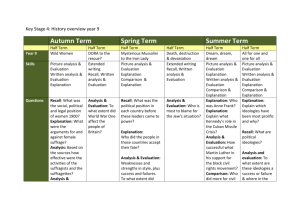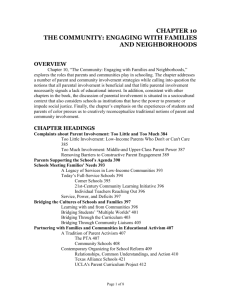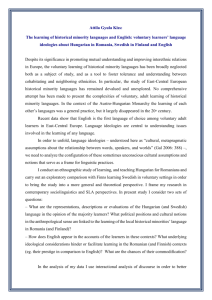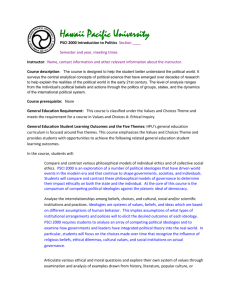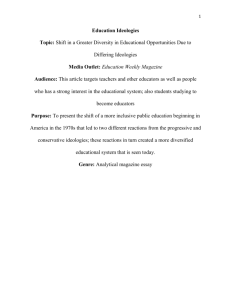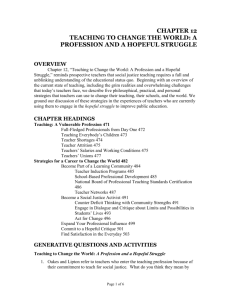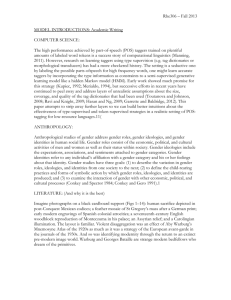Web Sites - McGraw Hill Higher Education
advertisement
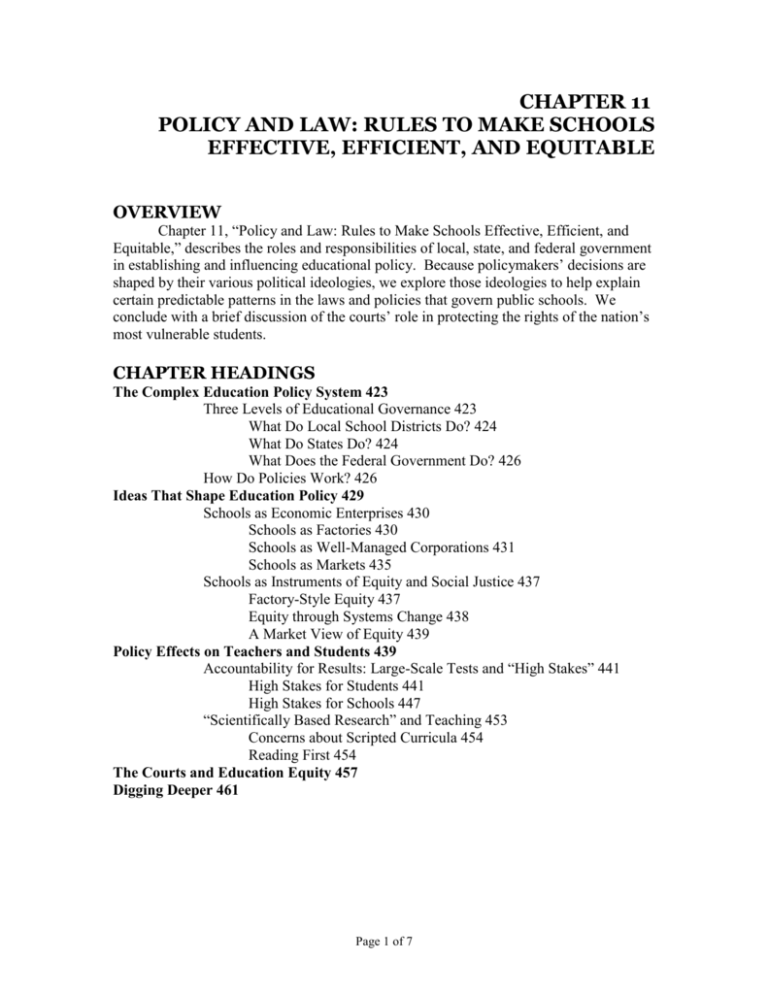
CHAPTER 11 POLICY AND LAW: RULES TO MAKE SCHOOLS EFFECTIVE, EFFICIENT, AND EQUITABLE OVERVIEW Chapter 11, “Policy and Law: Rules to Make Schools Effective, Efficient, and Equitable,” describes the roles and responsibilities of local, state, and federal government in establishing and influencing educational policy. Because policymakers’ decisions are shaped by their various political ideologies, we explore those ideologies to help explain certain predictable patterns in the laws and policies that govern public schools. We conclude with a brief discussion of the courts’ role in protecting the rights of the nation’s most vulnerable students. CHAPTER HEADINGS The Complex Education Policy System 423 Three Levels of Educational Governance 423 What Do Local School Districts Do? 424 What Do States Do? 424 What Does the Federal Government Do? 426 How Do Policies Work? 426 Ideas That Shape Education Policy 429 Schools as Economic Enterprises 430 Schools as Factories 430 Schools as Well-Managed Corporations 431 Schools as Markets 435 Schools as Instruments of Equity and Social Justice 437 Factory-Style Equity 437 Equity through Systems Change 438 A Market View of Equity 439 Policy Effects on Teachers and Students 439 Accountability for Results: Large-Scale Tests and “High Stakes” 441 High Stakes for Students 441 High Stakes for Schools 447 “Scientifically Based Research” and Teaching 453 Concerns about Scripted Curricula 454 Reading First 454 The Courts and Education Equity 457 Digging Deeper 461 Page 1 of 7 GENERATIVE QUESTIONS AND ACTIVITIES Policy and Law: Rules to Make Schools Effective, Efficient, and Equitable 1. In discussing the adverse effects of No Child Left Behind on his school, high school teacher Mark Hill describes what Oakes and Lipton call “the perverse effect in many schools of targeting resources and support toward students who are most likely to help the school meet its numerical target.” As a pre-service teacher who aspires to embody a social justice agenda, how do you respond to this practice? Do you agree that it is an unethical use of precious resources? What would you do if you saw this happening at your own school? How would you attempt to redirect additional resources and support to the students most in need? Discuss this issue in a small group. If possible, work with someone who will take a school administrator’s position in defense of this practice. Oakes and Lipton posit that “policymakers’ decisions are shaped by their various political ideologies” and that this helps explain “certain predictable patterns in the laws that govern the kinds of schools we have.” Provide one or two examples of current debates or controversies in your local school(s) that seem to align along particular political ideologies. The Complex Education Policy System 2. The authors note that “in recent years, mayors in some large cities like New York, Chicago, and Detroit have ‘taken over’ responsibility for the schools and either appoint the board members or the superintendent.” This trend seems to be gaining in popularity, as is evidenced by Antonio Villaraigosa’s current plan to assume at least partial control over public schools in Los Angeles. What do proponents of such “takeovers” say are the benefits? What do opponents say are the disadvantages? 3. Do you think that popularly elected school boards are essential for widespread public participation in schools? Or are these officials likely to be beholden to a few influential people who helped get them elected? Are there other ways to guarantee that schools listen to and are accountable to parents and community members—no matter what the governance structure is “at the top”? 4. The authors also suggest that “much of what states and local school districts do is now shaped, even controlled, by federal policy.” Describe how federal policies affect curriculum and instruction at a school with which you are familiar. Give specific examples. Ideas That Shape Education Policy 5. Oakes and Lipton argue that the ideologies of meritocracy, deficit thinking, and white privilege are “so pervasive that they enter into the policymaking arena as if they are natural and common sense.” Do you agree with this analysis? If so, list several instructional practices and match them with their supporting ideologies. In each case, explain why they match. If you disagree with this analysis, is it because you think that even though ideologies exist, they do not influence schools Page 2 of 7 in important ways; because you think that it is natural for all people to think this way—not just elites or those with more social power; or do you believe that in most schools people simply do not subscribe to these beliefs, and the authors’ analysis is wrong from the very beginning? 6. As the authors note, randomized trials (such as those used to test medical treatments) are currently seen as the most legitimate science upon which to base policymaking decisions. In your opinion, is this the best way to evaluate the effectiveness of curricula and instruction? What might complicate the use of these kinds of experiments in schools? How are curriculum and instruction different from medical treatments? What variables would it be difficult (if not impossible) to isolate when testing the effects of particular curricular innovations or instructional techniques? 7. The legacy of the factory, scientific management, and industrial efficiency continues to influence the way schools are organized today. What might an alternative model look like? If you could create your own school, what political ideologies would inform your decision-making? What policies would you implement in order to create your school? 8. David Berliner and Bruce Biddle argue that the charges leveled against schools by the A Nation at Risk report were hostile, politically charged, and largely untrue. Can you think of more recent examples of politically charged educational issues? How do different groups’ positions on these issues reflect different political ideologies? Brainstorm a list of recent educational policy decisions that seem to have been made based more on political ideology than on empirical research. 9. In describing the 1994 reauthorization of the Elementary and Secondary Education Act, Oakes and Lipton note that conservatives in Congress vehemently opposed setting standards for resources and learning conditions. As a result, they argue, the policies that emerged focused on “setting standards for what students should learn, in the absence of standards for the resources and conditions that such learning would require.” How do you suppose conservative politicians justify these policies? In your view, what political ideologies do these policies reflect? Why do you think conservative politicians were so strongly opposed to setting standards for resources and learning conditions? How do you make sense of this? 10. To what extent and in what ways do voucher plans, charter schools, and magnet schools reflect free-market ideologies? How are these three schooling alternatives similar and different? With a partner or in a group, conduct a debate on whether or not each of these plans undermines our commitment to public education. Be explicit about the particular political ideology that informs your respective positions/arguments. Be sure to do an Internet search of sites that support these market-oriented schooling philosophies. Page 3 of 7 Policy Effects on Teachers and Students 11. Oakes and Lipton note that “many of today’s ‘high stakes’ testing policies make students’ performance on a single test the only factor in making very important decisions, such as grade promotion and high school graduation.” How are these policies different from testing policies that were in place when you were a K-12 student? What do you suppose will be the long-term impact of these policies on students and schools? 12. The advocacy organization FairTest recommends the following policies as alternatives to high-stakes testing for grade promotion: targeted support and services for students; professional development for teachers; mixed-age classrooms; continuous relationships with teachers; and the development of a variety of assessment skills and tools. How do these policy alternatives for improving education for all students differ from the “exit exams” currently being used in states like California, Florida, and Illinois? In your view, what would be some of the likely outcomes if these policy alternatives were implemented? 13. The authors note that “exit exam policies have been adopted in states that teach most of the nation’s students of color and English learners.” Why are the states with the most students of color and English learners the same states that are imposing these high-stakes exams? The authors suggest that students in these states have fewer educational resources and opportunities, noting that in California, the highest rates of exam failure occur at schools with shortages of qualified teachers and other resource problems. However, many policymakers in these states claim that the threat of failing and of high rates of failure is prompting officials to make schools better. What is your view of this way to “leverage” school improvement for those students who tend to have the fewest opportunities? 14. In 1999, the National Academy of Sciences declared that accountability for school performance belongs to the whole system, from states to parents, and cannot be imposed only on students. Consequently, they concluded, high-stakes tests should only be used after changes in teaching and learning opportunities ensure that students have a genuine opportunity to learn what is tested. Oakes and Lipton note that these findings support the professional standards established by AERA, APA, and NCME that same year (see Chapter 6). Despite the fact that so many experts agree that a single measure should not be used to make high-stakes educational decisions, current policies continue to call for the use of a single test to hold students accountable. What if policymakers actually listened to the experts’ recommendations? What would policies informed by their recommendations look like? What if federal, state, and local school officials were held accountable for providing students adequate opportunities to learn? Brainstorm ideas for creating and implementing a “system-wide” accountability plan. Be as specific as possible. 15. Many of the teachers cited in this chapter describe pressures to comply with various federal, state, and local policies. Interview teachers at a school with Page 4 of 7 which you are familiar to see how their experiences and perspectives compare with those of the teachers featured here. What policies affect them (and their students) the most? How are they (and their students) affected? What pressures do they face with respect to these various mandates? What strategies, tactics, and practices do they rely on to confront or avoid these pressures? 16. W. James Popham describes three negative consequences that high-stakes tests have on curriculum and teaching: curricular reductionism, excessive drilling, and modeled dishonesty. Consider the situation at the school with which you are most familiar. Have you seen any of these consequences there? If so, which ones have you observed? In what ways have they manifested themselves? What other negative consequences do you think might result from the emphasis on highstakes testing? Likewise, describe instances where high-stakes tests are thought to be responsible for improved school opportunities and outcomes, and comment on these. 17. NCLB’s Reading First program stipulates that federal funds can be spent only on programs and practices that have been proven effective with “scientifically based research.” What does this policy suggest about programs and practices that teachers know to be effective based on their own (and their colleagues’) experiences in the classroom? Since this valuable knowledge cannot be experimentally controlled (and therefore is often dismissed as not “scientifically based”), many teachers find ways to infuse their own “best practices” into official and approved programs. Talk to experienced teachers and observe in classrooms to find evidence that teachers who are well-grounded in learning principles can find ways to infuse their professional expertise and social justice commitments into mandated programs. For example, Kimberly Min describes how she integrates science as a way of modifying and supplementing her district’s mandated reading program. What might be some other ways to go about modifying and supplementing mandated curricula? 18. One of the biggest complaints about “scientifically based” curricula is that they tend to “script” the teacher’s role. Visit a classroom in which the teacher uses a scripted curriculum. Observe the scripted lessons carefully, taking notes on the interactions and practices that you observe. At a later date, visit a classroom in which the teacher does not use a scripted curriculum. Observe the “unscripted” lessons carefully and take notes. Afterwards, write a brief summary describing the differences that you noticed between the two classes. What stood out to you? What appear to be some of the advantages and disadvantages of each class? How will you apply what you’ve learned to your own teaching? 19. Oakes and Lipton observe that under NCLB, most school districts with lowincome students and students of color must choose from a handful of approved reading programs and then monitor whether teachers are fully implementing the selected program. Meanwhile, districts serving white students and wealthier students tend to have much more discretion to select the curricula and instruction Page 5 of 7 that they deem most appropriate for their students. What beliefs and attitudes underlie this tendency to give teachers of low-income students and students of color less flexibility to respond to individual needs and local conditions, while districts with white students and wealthier students have greater independence and flexibility? Quickly brainstorm a fairly long list of possible reasons; then examine each for biases and inaccurate assumptions. 20. Given the history of racist and unjust court decisions in this country, to what extent should social justice educators look to the courts for solutions to educational inequality? How much justice can we realistically expect to result from the judicial process? If litigation is one component of a broader strategy to bring about more socially just education policies, what are the other components? How might litigation be integrated with more grassroots tactics in order to build a more powerful struggle for educational justice? WEB SITES http://www.asu.edu./educ/epsl/index.htm—The Education Policy Studies Laboratory at Arizona State University conducts research on student performance standards, assessment, commercialism in schools, curriculum, and language policy issues. http://www.epi.org/subjectpages/edu.cfm?CFID=622050&CFTOKEN=45095 343—The Economic Policy Institute (EPI) website features reports on the connections between education policy and economics. http://www.findlaw.com/01topics/37education/sites.html —Findlaw, a website for legal professionals, has a page with a list of websites of groups and resources related to education law. http://www.equaleducation.org/about.asp—A website on the Century Foundation’s Equality and Education project, which addresses issues of equal opportunities and civil rights. http://www.JustSchoolsCalifornia.org—This UCLA website provides up-todate information and resources about policies related to educational inequality in California, as well as about some of the grassroots and advocacy groups working to make schools more equitable. http://www.ucla-idea.org—Another UCLA website dedicated to providing information and resources on issues around educational activism, access, and inequality. http://www.civilrightsproject.harvard.edu—The Harvard Civil Rights Project website features dowloadable reports on education policy and law. Page 6 of 7 http://www.publiceducation.org/subscribe.asp—The Public Education Network offers a subscription service that provides weekly news updates national education policy. http://www.urban.org/education/index.cfm—The Urban Institute website has information related to demographics and education policy. Page 7 of 7


